How to Evaluate your Content Marketing Budget

Budgeting is a pivotal element of any content strategy. It is at the core of content operations and how you are actually delivering your content program.
When thinking about content marketing strategy, marketers often put a lot of emphasis on audiences, content pillars, formats and platforms, but through all of that, two things are the foundation of every initiative and tactic:
- The objectives and key indicators of success for your content program;
- The budgets that support this success and have a great influence on how the content program is delivered.
Part of our How to keep your content strategy alive series, this article focuses on the latter.
How much are organizations allocating to content marketing?
One question we often get at Toast when planning a new content marketing program is how much should be allocated to it.
As a baseline, we often turn to studies the Content Marketing Institute does every year.
The reports we used for this article are the following:
- B2C Content Marketing, Benchmarks, Budgets and Trends
- B2B Content Marketing, Benchmarks, Budgets and Trends
From these two reports, a few elements stand out on the subject of budgeting:
B2C Content Marketing Budgets.
From the organizations that are able to track the actual budget for content marketing (close to 60% of orgs are able to track specific spending that goes towards content initiatives), 29% spend less than 10% of their marketing budgets. The remaining content marketing teams vary a lot in their investments, with 31% spending more than half of their total marketing budget!
Here is the detailed breakdown:
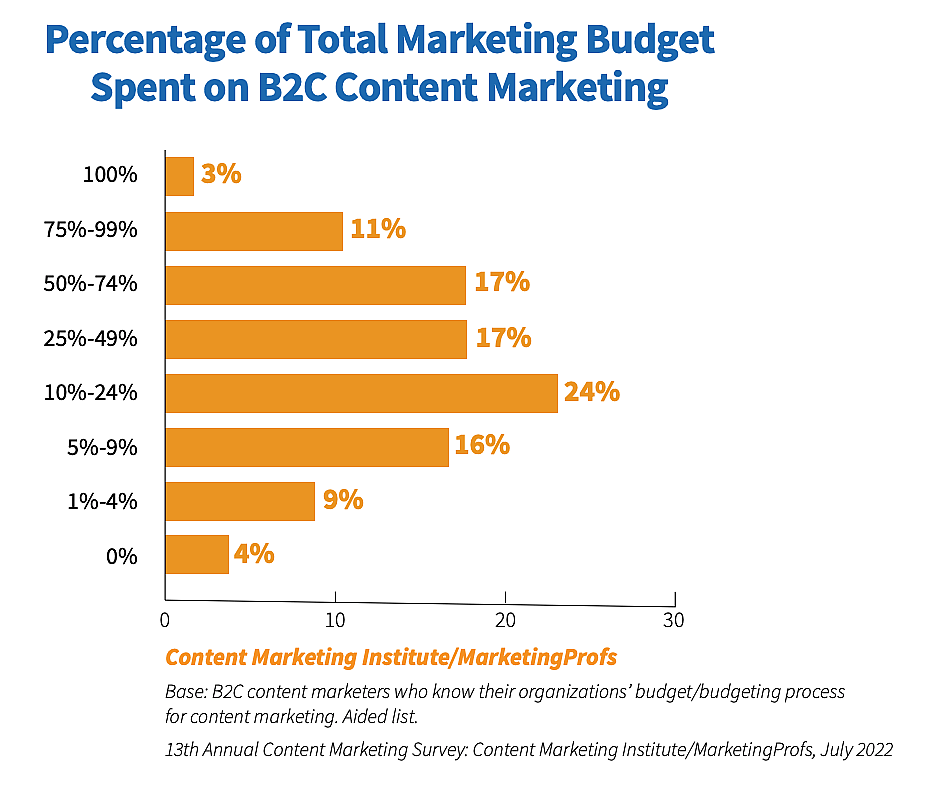
B2B Content Marketing Budgets.
In the B2B space, we’ve seen for many years how content marketing is seen as a very important aspect of sales and marketing initiatives.
Lately, as content has become more and more important in the B2C space, we are not seeing as much difference as we might have seen in the past.
Case in point (as about the same number of B2B and B2C organizations are able to track the ratio of investment dedicated to content, just over 60% in the case of B2B), just under a third of content teams spend less than 10% of the total marketing budget available, while 23% spend more than half.
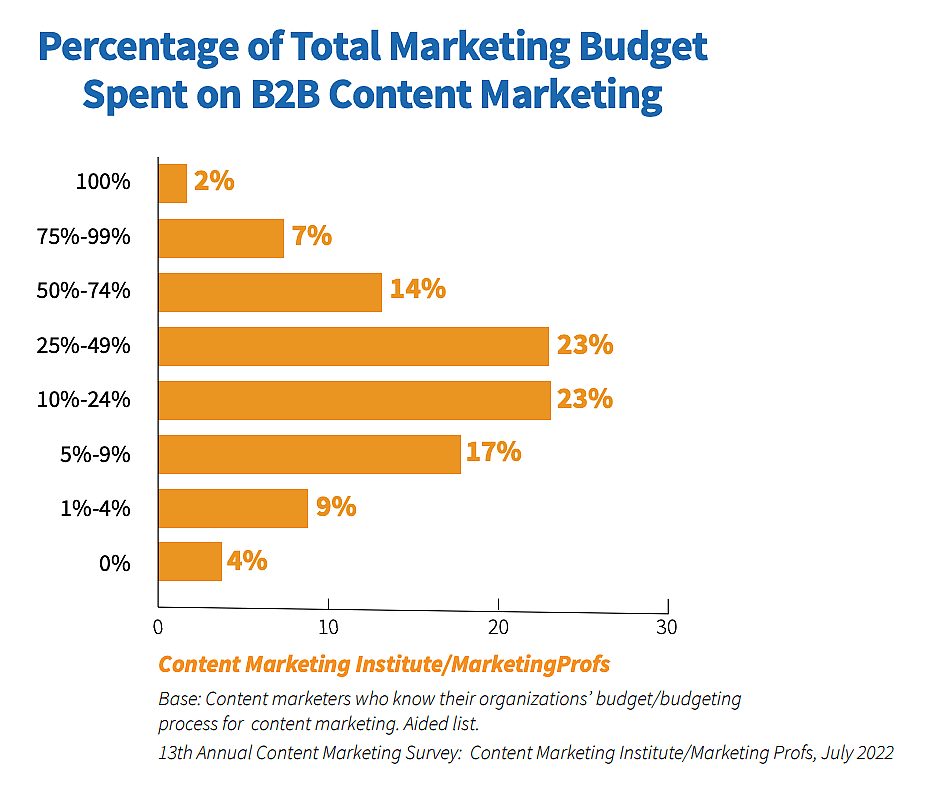
Are budgets for content marketing rising?
Through all this, one thing is certain: content marketing budgets are increasing.
In the B2B space, 50% are increasing budgets, with only 4% lowering the amount allocated to content marketing.
For B2C brands, 47% are increasing budgets, with only 3% knowing they are going to invest less.
But when considering budgets for the coming year, any Chief Content Officer needs to consider the current economic state and many organizations are shuffling budgets, or freezing increased investments, due to global economic conditions (and this is what we can see from the figures below).
Although some might say we are tooting our own horn, we do believe it is extremely important for marketing departments to maintain content budgets even in stormy economic times (a subject we’ve covered in a few articles: here, here and here).
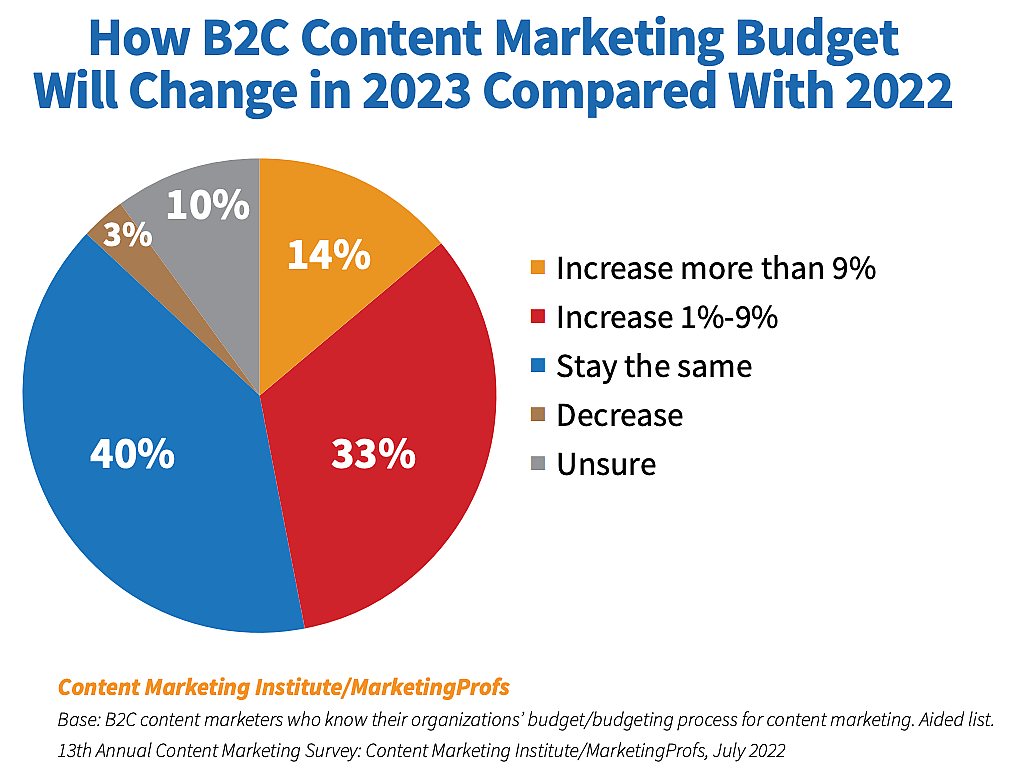
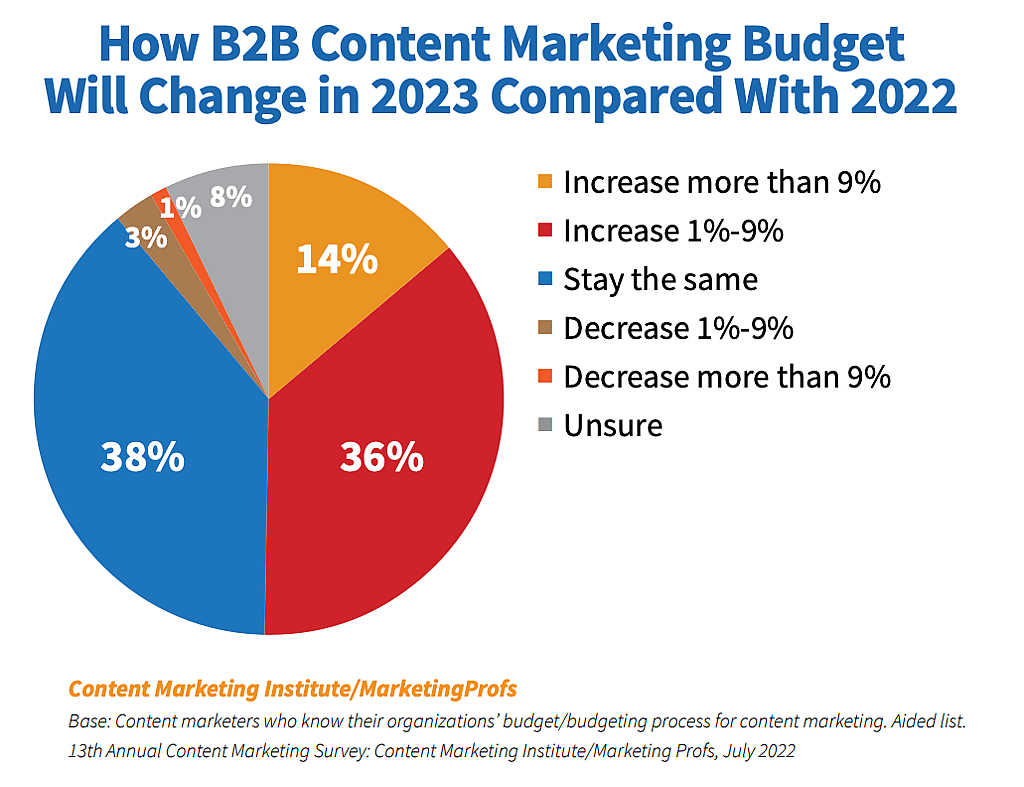
How are brands spending their content marketing budgets?
The variety in content marketing initiatives is very large. So how are content team leaders splitting their budget allocation?
Below are two tables that can help you gauge how you compare.
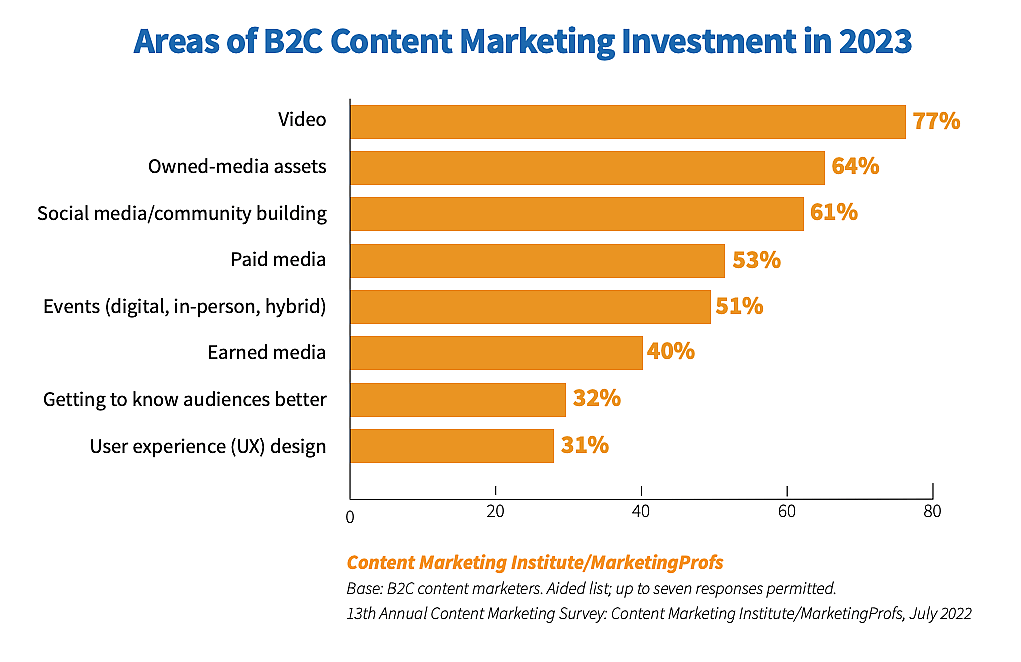
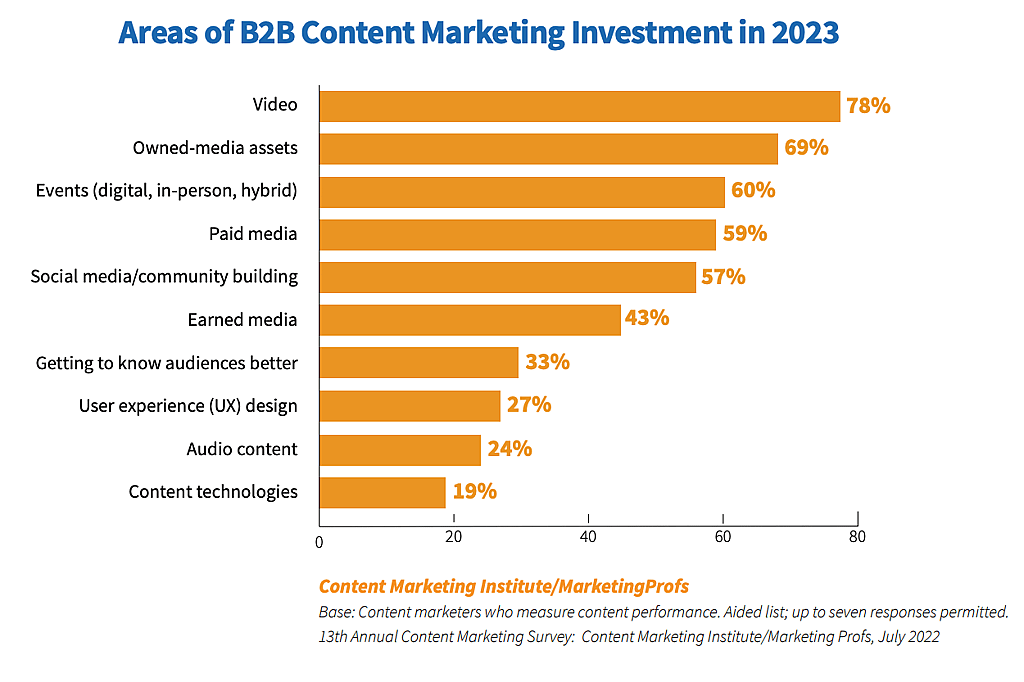
The main implications of a content marketing budget.
Having a better grasp on the size of your content marketing budget, it is important to make a list of implications and considerations to keep in mind when allocating funds to various parts of your content strategy.
1. Setting realistic expectations
A content marketing budget should be based on realistic business objectives that can be realistically achieved with the resources available.
Budgeting goes hand in hand with objectives. It is a bit a question of the chicken and the egg. Which comes first?
When we host workshops with clients on budgeting and objectives, one thing is sure, we oscillate between the two, adjusting budgets in function of business objectives we flag as important.
It is a delicate dance to get to the right balance that will allow you to have clear marketing goals.
Our recommendation is to start with clear objectives and work from there.
2. Identifying the necessary resources
The budget should include the costs for staff, technology, and other resources necessary to create and deliver content.
More and more, technology plays an important role in content marketing creation, management and reporting. In many cases, the right tool, even if it might seem a bit costly, can make or break results by allowing the content team to have a clear view of activities and results.
Another key element of budgeting for content marketing is to evaluate which resources are necessary (of course) but also making the right decisions on if those resources are better in-house or through an external partner, content marketing agency or freelancer.
We’ve seen, in the past 5 years, how many content marketing teams are beefing up their internal capabilities, but as they start the process of internalizing talent, they will often end up relying a bit too much on what we call a staff unicorn: an individual with great capabilities that is able to ideate, produce and distribute content on multiple platforms.
These individuals are perfect, but as they often do a great job, the workload increases and it becomes hard for content leaders and management to “break” it into distinct roles. This is an important aspect of internalization that needs to be considered by marketing executives. It is not only true for content marketing programs, but we’ve seen how often it happens with the clients we work with at Toast.
3. Allocating funds for promotion
Funding must be allocated to ensure that your content is seen by as many people as possible. This includes paid media campaigns, SEO optimization, social media outreach, and influencer marketing, among others.
Rule of thumb: 70% of effort should be dedicated to actually activating your content plan.
We covered this in great detail in our article The branded content production ratio: 30-70.
As you are working your Excel sheet for next year’s content marketing budget, try to keep this ratio in mind. It is easy to overlook this and concentrate investments towards production and content creation, but this can lead to great content that has too little traction because it wasn’t activated properly.
4. Prioritizing investments
Not all content initiatives are created equal – it’s important to prioritize which activities will have the most impact on your desired outcomes and allocate more of your budget towards those areas.
“Hero, hub, help.” These are three words that should be part of any Chief Content Officer’s agenda during budget season.
How will you be splitting content marketing efforts and funds between your high-quality content, large-scale productions (Hero), your snackable and always-on content initiatives (Hub) and your evergreen content (Help)?
We are using and quoting Google’s famous framework in this section. It has been a great foundation and guide to help content teams categorize content and effort towards creating, producing and distributing it.
It is imperative that you have some form of guiding framework to orient the types of content production investments you will make throughout the year.
5. Tracking results
Your budget needs to include sufficient funds to track results so you can make adjustments or cut spending when needed to maximize ROI.
If you’ve done the work properly and have clear objectives and indicators, you MUST make sure you will actually have time and means to measure it.
Budget and plan for measurement.
It can be an internal resource, an external partner that generates insights for you throughout the year, but one thing is sure: Plan for it.
Do not just publish and pray it works, dedicate time and resources to be able to measure and adapt.
6. Planning for long-term success
Long-term success requires consistent investment in content creation and promotion over time, not just a one-time burst of activity followed by silence. Make sure you plan accordingly when creating your budget so you can sustain performance over time.
If you’ve been following us for a while, you know we often say that content marketing is a marathon, not a sprint. This means that when budgeting for the coming year, be sure to allocate resources that will allow you to maintain the rhythm throughout the year.
And be sure to create Plan Bs and Plan Cs that you will be able to deploy should something happen and you had to cut or adjust budgets (economic climate, strategic initiatives by the business owners, etc.).
One thing you want to the sure about is that you can still keep the lights on and keep a presence with your audiences throughout the year, no matter what happens.
Budgeting for your content marketing program depends on your specific situation.
Although the guidelines and considerations above can give you an idea of how you compare and what others might be doing, your specific situation is the main driver of how to invest in content marketing.
No two organizations are built alike, with the same challenges, with the same business objectives.
You are, of course, building your very own content marketing budget and planning. This is where one must stay nimble, yet plan for strong results and growing audiences.



